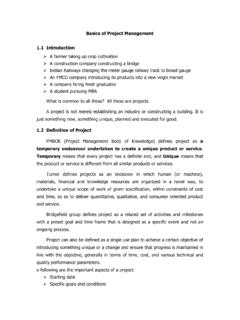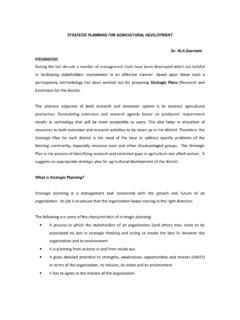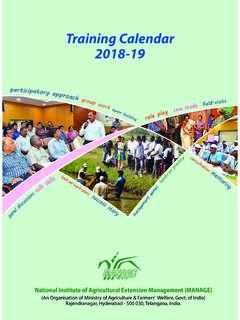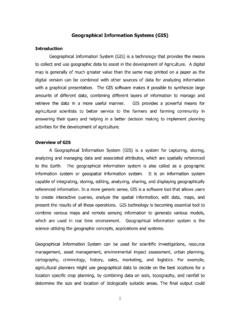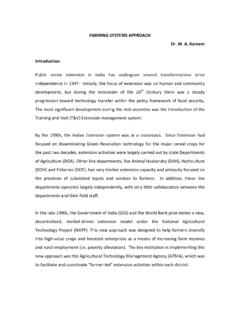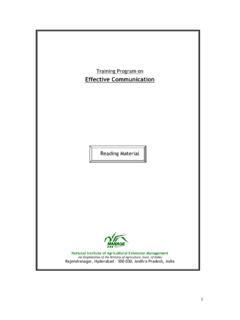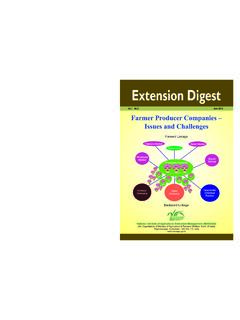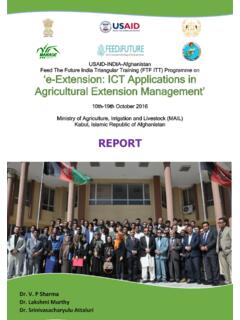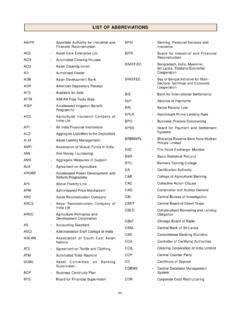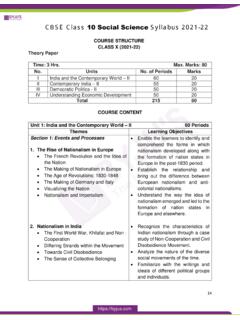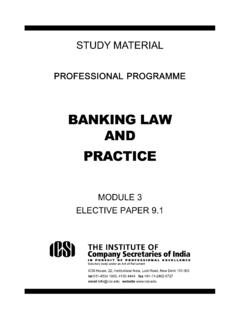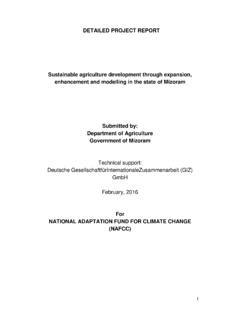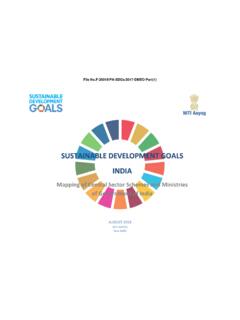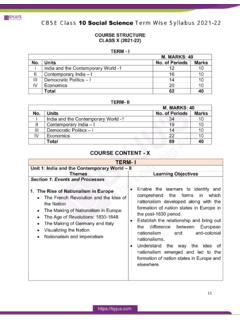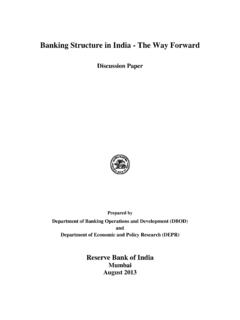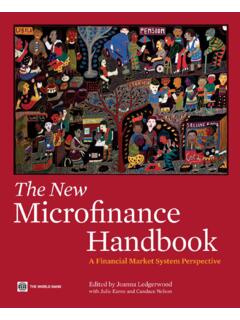Transcription of Farmer’s Handbook on Basic Agriculture
1 A holistic perspective of scientific agricultureA joint initiative to impart farmers with technical knowledge on Basic s Handbook on Basic AgricultureDisclaimer:The opinions expressed provided in this publication are those of the authors and do not necessarily reflect those of GIZ . The designations employed and the presentation of material in this publication do not imply the expression of any opinion what-soever on the part of GIZ concerning the legal status of any country, territory, city or area, or concerning the delimitation of its frontiers or boundaries.
2 Farmer s Handbook on Basic AgricultureFarmer s Handbook on Basic AgriculturePrepared & compiled byDr. P. Chandra ShekaraNational Institute of Agricultural Extension Management (MANAGE)Ministry of Agriculture , GoIHyderabad, Andhra PradeshIndiaDr. N. BalasubramaniNational Institute of Agricultural Extension Management (MANAGE)Ministry of Agriculture , GoI Hyderabad, Andhra PradeshIndiaDr. Rajeev SharmaDr. Chitra ShuklaDesai Fruits & Vegetables Pvt. , GujaratIndiaDr. Ajit KumarDesai Fruits & Vegetables Pvt. , Gujarat IndiaBakul C.
3 ChaudharyDesai Fruits & Vegetables Pvt. , Gujarat IndiaMr. Max BaumannPlanning OfficerSection Agricultural Production & Resource Use Division 45 - Rural Development and AgricultureDeutsche Gesellschaft f r Internationale Zusam-menarbeit (GIZ) byDesai Fruits & Vegetables Pvt. , Gujarat, IndiaGerman Federal Ministry for Economic Cooperation and Development (BMZ)Published byDesai Fruits & Vegetables Pvt. , GujaratIndiaSecond Edition: August 2016 The Authors acknowledge the contribution of following experts/professionals in developing the Handbook .
4 Mr. Max Baumann, Planning Officer, GIZ, GermanyMr. Fredrick Oberthur, Planning Officer, GIZ, GermanyMr. Ajit Kumar Desai, Chairman, DFV, Navsari, Gujarat Dr. Sashidhar, Professor, University of Agriculture and Horticultural Sciences, Shimoga, KarnatakaDr. Syed Ahmed Hussain, Professor, ANGRAU, Hyderabad, TelanganaMr. ,Agricultural Officer, Pesticide Testing Laboratory, Dharmapuri, TamilnaduDr. , Former Dean, ANGRAU, Hyderabad, TelanganaDr. K. Kareemulla, Principal Scientist, NAARM, Hyderabad, TelanganaDr. Jayaraghavendra Rao, Principal Scientist, NAARM, Hyderabad, TelanganaMr.
5 Thomas A Vivian, Assistant Professor, College of Agriculture , Dhule, MaharastraProf. T. M. Bahale, Professor of Agronomy, College of Agriculture , Dhule, MaharastraDr. R. K Rahane, Professor of Agricultural Economics, College of Agriculture , Dhule, MaharastraDr. G. D. Patil, Professor of Soil Science & Agricultural Chemistry, College of Agriculture , D hule, MaharastraDr. D. N. Padule, Professor of Plant Pathology, College of Agriculture , Dhule, MaharastraDr. A. R. Pathak, Vice Chancellor, Navsari Agricultural University, Navsari, Gujarat Dr.
6 J. B. Patel, Professor, Anand Agricultural University, Anand, Gujarat Dr. Bhaskar Gaikwad, Programme, Coordinator, KVK, Babhaleshwar, Maharashtra Mr. Mahendra Dhaibar, CEO, Sustainable Agricultural Development Foundation, Pune, Maharashtra Dr. R. M. Pankhaniya, Associate Professor, Department of Agronomy, NM College of Agriculture , Navsari Agricultural University, Navsari, GujaratDr A. M. Bafna, Principal & Dean, Aspee Agri-Business Management Institute, Navsari Agricultural University, Navsari, GujaratDr G. G. Radadia, Professor & Head, Department of Entomology, NM College of Agriculture , Navsari Agricultural University, Navsari, GujaratDr B.
7 P. Mehta, Professor, Department of Plant Pathology, Aspee College of Horticulture and Forestry, Navsari Agricultural University, Navsari, GujaratDr. L. J. Desai, Associate Professor, Department of Agronomy, NM College of AgricultureNavsari Agricultural University, Navsari, Gujarat Dr. N. S. Manohar, Associate Professor, Department of Agricultural Economics, Aspee College of Horticulture and Forestry, Navsari Agricultural University, Navsari, GujaratDr O P Sharma, Associate Professor & Head, Department of Extension Education, College of Veterinary Science & AH, Navsari Agricultural University, Navsari, GujaratDr.
8 Bruno Schuler, Advisor and Planning Officer, Sustainable Agriculture -Rural Development, GIZ, GermanyMr. Rajiv Ahuja, Technical Expert, Natural Resource Management, GIZ, IndiaMr. Akhil Dev, Junior Technical Expert, Natural Resource Management, GIZ, IndiaFarmer s Handbook on Basic AgricultureAcknowledgementHigher demand for agricultural raw material is now anticipated and Agriculture is not any more about producing farm products and selling them exclusively at the local market. Instead farmers today have a world market to serve.
9 But the new chances bring new challenges. Farmers and agricultural enterprises, willing to be part of the new expanding world market, not only have to take into consideration customers preferences whom they want to serve, but also adhere to international trade regulations set by WTO and comply with high production and quality standards required by the importing contributes around 17% to GDP and continues to be among the most important and success-ful sectors in india . Around 58% of the Indian population depend on Agriculture for their livelihood.
10 Apart from delivering the local industries with top quality raw materials for processing, Agriculture provides almost 10% of total export earnings. However, to support the impressive Indian economic growth in the coming years, Agriculture will have to contribute more towards value addition, productivity enhancement, high quality products and trained manpower to successfully tackle these states of Gujarat and Maharashtra have competitive advantages for the production of several com-modities. However, productivity and competitiveness remains low.
